The Steinway Diaries at the Smithsonian
Smithsonian Institute Brings 19th Century Queens Alive
Time Is Running Out - Steinway Mansion Contents Being Auctioned
February 19, 2011 / Astoria / NYC Neighborhoods & History NYC / Steinway Mansion History & Steinway Hall NYC / Gotham Buzz NYC.
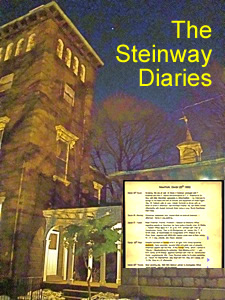 On Monday, March 7th at 7 pm the Greater Astoria Historical Society will be hosting the Smithsonian Institution’s presentation of the William Steinway Diaries.
On Monday, March 7th at 7 pm the Greater Astoria Historical Society will be hosting the Smithsonian Institution’s presentation of the William Steinway Diaries.
These diaries are a first person account written by one of the most influential people in the emerging American metropolis of New York City in the latter half of the 19th century. The diaries begin in 1861 around the time of William Steinway’s first wedding [and the beginning of the American Civil War] and continue throughout the rest of his life, terminating only weeks before he died in 1896.
I had the opportunity to talk with Bob Singleton, Executive Director of the Greater Astoria Historical Society in anticipation of the Smithsonian Institution’s presentation of the Steinway Diaries on March 7th. He took me through some of the interesting things to investigate using the online project that was the Smithsonian’s “largest and longest-running volunteer research efforts”. A copy of one of the transcribed pages from the Smithsonian's Steinway Diaries website is shown inset in a photo of the Steinway Mansion in Astoria.
The general public is welcome to the March 7th presentation, and it is highly recommended that you purchase / rsvp tickets in advance. Click here to read our look into the William Steinway Diaries.
The Steinway Diaries at the Smithsonian
Smithsonian Institute Brings 19th Century Queens Alive
The Smithsonian Brings 19th Century Queens Alive
March 3, 2011 / Astoria / NYC Neighborhoods & History NYC / Steinway Mansion History & Steinway Hall NYC / Gotham Buzz NYC. Continued.
William Steinway – Longtime Astorian Roots
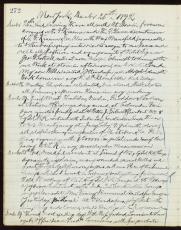 I recently had the opportunity to interview Bob Singleton, Executive Director of the Greater Astoria Historical Society [GAHS] about the Steinway Diaries, which are to be presented on Monday, March 7th at the GAHS. Bob has been involved with the GAHS for the past fifteen years, and during this time had come to know and befriend, Henry Z. Steinway, who passed away in 2008. Henry was the great grandson of William H. Steinway who was the author of the diaries. The image to your left is of an original page taken from the William Steinway Diaries as shown on the Smithsonian website, a link to which is provided below.
I recently had the opportunity to interview Bob Singleton, Executive Director of the Greater Astoria Historical Society [GAHS] about the Steinway Diaries, which are to be presented on Monday, March 7th at the GAHS. Bob has been involved with the GAHS for the past fifteen years, and during this time had come to know and befriend, Henry Z. Steinway, who passed away in 2008. Henry was the great grandson of William H. Steinway who was the author of the diaries. The image to your left is of an original page taken from the William Steinway Diaries as shown on the Smithsonian website, a link to which is provided below.
Astorians’ Involvement & Rare First Person Account
Henry Z. Steinway donated his great grandfather’s diaries to the Smithsonian Institution over ten years ago. In so doing, he also introduced the Smithsonian to Bob Singleton and the GAHS, who were called upon a couple of times to help research local events / people to support the narrative associated with the diaries.

Bob noted that it is unusually rare to find this sort of first person account of events by an influential person. He also noted that two Astorians were instrumental in helping make the Steinway Diaries project a reality: Anna Karvellas, who is the Managing Editor and Exhibition Curator, and Kenneth Bailey who was a researcher on the project since 2002. Bob Singleton of Greater Astoria Historical Society is shown in the photo to your right.
The Smithsonian Institution – Steinway Diaries
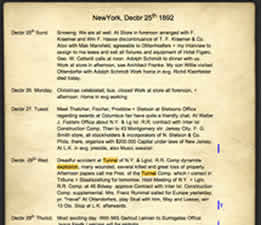 This is a remarkable project in many respects. As noted in the introduction is was the Smithsonian’s “largest and longest-running volunteer research efforts”. The text had to be copied, in some cases translated [small bits were written in William's native German tongue], transcribed, annotated and put in context. Over 100 highly educated, qualified volunteers worked over the course of about a decade to make this work a reality.
This is a remarkable project in many respects. As noted in the introduction is was the Smithsonian’s “largest and longest-running volunteer research efforts”. The text had to be copied, in some cases translated [small bits were written in William's native German tongue], transcribed, annotated and put in context. Over 100 highly educated, qualified volunteers worked over the course of about a decade to make this work a reality.
The Smithsonian Institution has put the entire work online and it’s a fascinating first person account of New York, America and Long Island City / Astoria / Queens history. The image to your right was taken from the Steinway Diaries website, a link to which is provided at the end of this report.
The Steinways – Idealistic, Innovative 19th Century German Immigrants
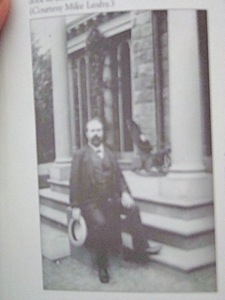 Living amidst this splendor, was a very ambitious, hardworking and idealistic German American family. The William Steinway Diaries include notes about the continuous interactions of the Steinways with the key people in their employ, as well as their continuous involvement in the development of the emerging metropolis’ infrastructure. The diaries go from the very personal to routine transactions, to high finance to the politics of the day. And they show a German American idealism, prevalent during that time, that people can build better lives for themselves and their communities. A photo of William Steinway standing in front of the Steinway Mansion is shown to your right, compliments of the Greater Astoria Historical Society [GAHS].
Living amidst this splendor, was a very ambitious, hardworking and idealistic German American family. The William Steinway Diaries include notes about the continuous interactions of the Steinways with the key people in their employ, as well as their continuous involvement in the development of the emerging metropolis’ infrastructure. The diaries go from the very personal to routine transactions, to high finance to the politics of the day. And they show a German American idealism, prevalent during that time, that people can build better lives for themselves and their communities. A photo of William Steinway standing in front of the Steinway Mansion is shown to your right, compliments of the Greater Astoria Historical Society [GAHS].
The Steinways embarked on a sort of utopian ideal community while helping to develop the community of Astoria. The Steinway Diaries contain accounts of the Steinways either building or helping to build all kinds of community infrastructure including kindergartens, schools, churches, trolley service, post offices, fire company houses as well as providing the community with jobs while developing and selling the property. A photo of one of the Steinway Reformed church is shown below. It is one of the churches still standing.
Steinway Diaries - Queens History Breadth
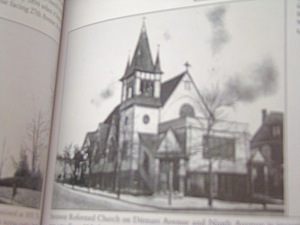 The diaries contain over two and a half thousand pages written by William Steinway primarily in English. They contain information about his personal life, such as how many times he had sex with his wife which was written in a deciphered code, as well as about a myriad of topics ranging from the competitive piano business, show business, local politics, Tammany Hall and so many projects with which the Steinway family immersed themselves. It also contains notes about meetings with a lawyer from Buffalo who William Steinway befriended while settling an estate. The notes mentioning this lawyer by name were made after he became president of the United States of America: Grover Cleveland.
The diaries contain over two and a half thousand pages written by William Steinway primarily in English. They contain information about his personal life, such as how many times he had sex with his wife which was written in a deciphered code, as well as about a myriad of topics ranging from the competitive piano business, show business, local politics, Tammany Hall and so many projects with which the Steinway family immersed themselves. It also contains notes about meetings with a lawyer from Buffalo who William Steinway befriended while settling an estate. The notes mentioning this lawyer by name were made after he became president of the United States of America: Grover Cleveland.
Steinway Diaries – Queens History In Depth
Before I began my own journey into the online diaries of William Steinway, I asked Bob what was in them. He said they contained a running log of the people with whom William H. Steinway met nearly daily, from the factory foremen, to would-be musicians, to star performers and local government officials. It documented the daily doings of a wealthy, intellectually- curious, 19th century Renaissance American.
William Steinway Diaries – Personal Interests
Bob talked about the many projects with which William Steinway became involved. He said that lore has it that the Steinway Mansion midnight oil oftentimes burned late. The Steinways were known to be avid players of the card game whist, which was a trick taking card game popular in Europe in the 18th and 19th centuries. The famous card playing author Hoyle also wrote about it. In the diaries, Steinway talked about losing and winning amounts that appeared to run between two and fifty cents, so I imagine the table stakes were more friendly than real.
Steinway Mansion – Last Of Great Summer Homes
 The Steinway Mansion, was William Steinway’s summer home, and is the last remaining [unspoiled] great East River Mansions. The Steinways moved into the summer home while Queens was still the countryside of the emerging American city of New York. William tells of carriage rides and automobile rides through the Queens countryside. And about having people over to dinner. Bob Singleton mentioned that dinner guests included relatives to Edith Wharton and FAO Schwartz. A street lined with mansions in Astoria is shown in the photo to your right courtesy of the GAHS.
The Steinway Mansion, was William Steinway’s summer home, and is the last remaining [unspoiled] great East River Mansions. The Steinways moved into the summer home while Queens was still the countryside of the emerging American city of New York. William tells of carriage rides and automobile rides through the Queens countryside. And about having people over to dinner. Bob Singleton mentioned that dinner guests included relatives to Edith Wharton and FAO Schwartz. A street lined with mansions in Astoria is shown in the photo to your right courtesy of the GAHS.
Bob conjectured that it’s possible the Steinways made modifications to the mansion to enhance its acoustics, so that piano performances could be played in the main foyer. The mansion today still has wood burning fireplaces in nearly every large room and the large doors in the living rooms, dining room and front entrance which open out in three directions onto the great mansion lawn which rested on a bluff overlooking the East River.
In his diaries William talks about taking yacht rides, which I believe sometimes docked along the East River down the hill from the mansion. The photo to your right is of the mansion overlooking the East River many years ago. This photo was provided compliments of Michael Halberian.
William Steinway Diaries – NYC Mass Transit
 Bob informed me that William E. Steinway was involved in the development of the underground subway system, pretty much from the outset. NYC had mass transit via elevated trains beginning in the 1870’s following the Civil War. William Steinway was New York City’s second NYC Subway Commissioner, and somewhat visionary during a time when the city was planning to take its mass transit system underground.
Bob informed me that William E. Steinway was involved in the development of the underground subway system, pretty much from the outset. NYC had mass transit via elevated trains beginning in the 1870’s following the Civil War. William Steinway was New York City’s second NYC Subway Commissioner, and somewhat visionary during a time when the city was planning to take its mass transit system underground.
The Steinways owned a trolley car system in Long Island City / Astoria, and in anticipation of growing the transportation business, began digging a tunnel under the East River. A large accidental explosion of dynamite shut down the operation and sent it into litigation, not long after the effort began. Eventually digging on the tunnel resumed and today it is the same tunnel used by the number 7 subway line.
The Steinway Diaries – American Automobile Patents [Daimler later merged with Mercedes]
William Steinway also took an interest in the automobile. Following a visit to Germany in 1888, the Steinways bought the U.S. patents to Daimler Benz self-propelled motors and opened a plant to build them for street cars and boats. The assignment of the Daimler patents is noted in the diaries, as William was remarkably transparent in the recording of his business transactions.
Following William’s death, the automobile company was re-incorporated as Mercedes and a factory on Long Island was opened to build motors for small trucks. To our knowledge there is at least one automobile in existence today that was built by the Mercedes factory in which the Steinways held a significant interest.
The Queens Borough Bridge & Mass Transit
 The diaries also provide a running account of some of the planning for the erection of the infrastructure that opened up Queens to development. Steinway was involved in planning the two main transportation conduits into Queens at the turn of the 20th century, the #7 line subway tunnel and the Queens Borough Bridge. These two large transportation projects continue to serve Queens, and today remain a significant part of the Queens transportation infrastructure. The photo to your right was provided compliments of the Jackson Heights Beautification Group.
The diaries also provide a running account of some of the planning for the erection of the infrastructure that opened up Queens to development. Steinway was involved in planning the two main transportation conduits into Queens at the turn of the 20th century, the #7 line subway tunnel and the Queens Borough Bridge. These two large transportation projects continue to serve Queens, and today remain a significant part of the Queens transportation infrastructure. The photo to your right was provided compliments of the Jackson Heights Beautification Group.
William Steinway was the second Commissioner of NYC Rapid Transit. As such he initiated a project to tunnel under the East River. He informs us that this effort was put on hiatus shortly after it had begun, due to a terrible unplanned dynamite explosion. He also talks about the plans for building a bridge across the East River in 1879, thirty years before it happened and thirteen years after his death.
Steinway Mansion Is Queens, NYC & U.S. History
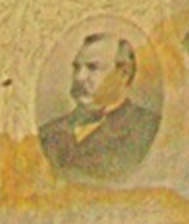 Bob had all sorts of lines of questioning he seemed interested in pursuing. He wondered where the granite for the Steinway Mansion had come from. Who was the builder of the Steinway Mansion and did they use any edifices sold in building catalogues of the time? He noted that there had been speculation about William Steinway becoming a member of President Grover Cleveland’s cabinet even though it had not been recorded in the diaries [wouldn’t want that to slip out]. To your right is a photo of Grover Cleveland I found in the attic of the Steinway Mansion which we're publishing with permission from Michael Halberian.
Bob had all sorts of lines of questioning he seemed interested in pursuing. He wondered where the granite for the Steinway Mansion had come from. Who was the builder of the Steinway Mansion and did they use any edifices sold in building catalogues of the time? He noted that there had been speculation about William Steinway becoming a member of President Grover Cleveland’s cabinet even though it had not been recorded in the diaries [wouldn’t want that to slip out]. To your right is a photo of Grover Cleveland I found in the attic of the Steinway Mansion which we're publishing with permission from Michael Halberian.
All in all, the Steinway Diaries represent a fascinating account of one of the most prominent denizens of New York City, as the city and the nation were emerging as the business, economic and media center of the young American republic.
Smithsonian Institution – The Steinway Diaries Link
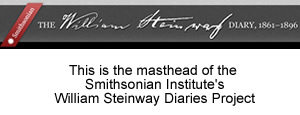 We must be thankful that the Smithsonian Institution has nurtured such an important project, and can only hope that New York City government officials don’t realize too late, the importance of saving one of the last remaining East River mansions, which was also the home to one of New York’s and America’s most prominent and influential citizens: William Steinway. Click here to read the Steinway Diaries made possible by the Smithsonian Institute.
We must be thankful that the Smithsonian Institution has nurtured such an important project, and can only hope that New York City government officials don’t realize too late, the importance of saving one of the last remaining East River mansions, which was also the home to one of New York’s and America’s most prominent and influential citizens: William Steinway. Click here to read the Steinway Diaries made possible by the Smithsonian Institute.
Steinway Diaries Presentation - March 7th GAHS
 Click here to view a location map of The Greater Astoria Historical Society. And call them at 718.278.0700 to reserve a ticket to this important presentation on March 7th.
Click here to view a location map of The Greater Astoria Historical Society. And call them at 718.278.0700 to reserve a ticket to this important presentation on March 7th.
No Progress Being Made To Save Steinway Mansion
As far as we know, nobody from the Mayor's office has even visited the Steinway Mansion, in spite of numerous reports in the New York Times, Daily News and New York One - not to mention the plethora of reports in Queens own newspapers and websites.
As for support from Queens government officials, we've seen a lot of vocal support, and early on there was a brief stirring of initiative. But as far as we know, at present, little progress has been made to save the Steinway Mansion.
We continue to make inquiries and naturally we will apprise you of any serious efforts to save the mansion, be it private or public, as it is becomes known. See Benjamin Pike story for an update.
Time Is Running Out / Steinway Mansion Contents Being Auctioned
As of March 26th some of the contents from the Steinway Mansion were auctioned off at an auction house at 36-01 Queens Blvd in Long Island City. The second auction will take place on April 30th. This is the first step in losing an important part of our cultural heritage. Michael Halberian's collection of New York history was worthy of a Queens museum. Will the Steinway Mansion become to Queens, what the loss of Penn Station was to Manhattan?
New York City receives 48 million tourists each year. The Steinway factory is toured by thousands each year in spite of no advertising and in spite of very limited visiting seasons / days / hours. It's not inconceivable that this site could become a major tourist attraction into the area, bringing with it tourist spending on hotels, restaurants and shops.
Please ask NYC & Queens government officials what actions they are taking to preserve this site, as we are in danger of losing it.
This email address was provided by the Mayor's Office of Economic Development: rgold1@cityhall.nyc.gov. An email address to the Borough President's Office was solicited but we never received a reply, so try emailing Theresa Osborne as she's the Director of Culture & Tourism for Queens - tosborne@queensbp.org.
Special Thanks To The Smithsonian Institution & Greater Astoria Historical Society
We express our thanks and gratitude to the Smithsonian Institution and its volunteers who made this exciting online project possible. And we thank the Greater Astoria Historical Society and Bob Singleton for their help in putting together this report.
NYC Neighborhoods & History - Queens Borough Links
Click on these advertisements for promotions, discounts and coupons by retailers and restaurateurs in Astoria and nearby LIC.
Site Search Tips. 1) For best results, when typing in more than one word, use quotation marks - eg "Astoria Park". 2) Also try either singular or plural words when searching for a specific item such as "gym" or "gyms".
$element(bwcore,insert_search,N)$
$element(adman,groupad,Sectional2 Ad)$
Click the log in link below to create an ID and post an opinion.
Or send this story to a friend by filling in the appropriate box below.















